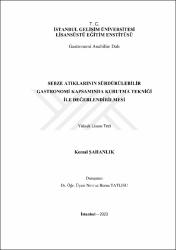Sebze atıklarının sürdürülebilir gastronomi kapsamında kurutma tekniği ile değerlendirilmesi
Özet
Artan nüfus ve toplumsal yaşamın yönlendirilerek oluşturduğu endüstri, mevcut talep ve arzın beraberinde de atığın boyutsal dengesizliğine yol açmıştır. Popüler kültürün de etkilediği tüketim artışı, her sektörden büyümeye ancak önlenmesi güç ve maliyetli çözümlere neden olmaktadır. Özellikle nüfusun yoğun olduğu kentleşmenin arttığı alanlardan çıkan atıkların geri dönüşümü, kazanımı ya da bertarafı ülkesel olarak üzerinde yoğunlaşılan bir problem halini almıştır. Atıkların bertaraf edilmesi nedeniyle ortaya çıkan sera gazları ve endüstrinin büyümesi nedeniyle artan karbon salınımı, iklimin değişmesine dolayısı ile tarımın zorluğuna dahasında gıda verimsizliğine yol açmaktadır. UNDP' nin raporlarına göre beklenen kıtlık ve su sıkıntısı bu durumun bir sonucudur. Gıdanın üretimi, işlenmesi, hazırlanması, sunulması ve tüketimi dahil her süreçte atık oluşabilir. Bu nedenle gıdalardan arta kalan kısımların kullanım olanaklarının belirlenmesi ve alternatif çözüm önerileri sunulması önem arz etmektedir. Bu tez çalışmasında bu hedefle, en çok tüketilen bitkisel taze gıda grubu olan sebzelerin, kullanılmayan kısımlarının kurutma tekniği kullanılarak, raf ömrünün uzatılması ve tekrar kullanılabilir forma uyarlanması amaçlanmıştır. Bu kapsamda çalışmada, 2021 yılı TÜİK üretim verilerine göre ilk 5 sırada bulunan yeşil biber, patates ve patlıcan sebzeleri gıda atığı olarak değerlendirilmiştir. 1061.5 gramlık patatesten 138.5 gram atık kabuk, 1013.5 gramlık yeşil biberden 206 gram sap ve çekirdek atığı, 1043.5 gramlık patlıcandan ise 183 gramlık kabuk ve sap atığı ortaya çıkmıştır. Değerlendirme yöntemi olarak geleneksel saklama yöntemlerinden en kısa ve etkili yöntem olan kurutma metodu kullanılmıştır. Kurutulan atıklar daha sonrasında öğütücü cihazdan geçirilerek toz haline getirilmiştir. Toz haline getirilen atıklar, profesyonel mutfaklarda da sık sık kullanılmaya başlanılan, modern sunum tekniklerinden biri olan köpürtme yöntemiyle köpük haline getirilmiştir. Gastronomik aksesuar olarak kullanılabilmesi için elde edilen köpük örneklerinin patatesli, yeşil biberli ve patlıcanlı olmak üzere asitlik (pH: 5,71, 5.30 ve 5.42), kuru madde (%32, %28, ve %30), renk ve duyusal analizler ile parametreleri belirlenmiş ve tüketime uygunlukları hakkında sayısal değerler üzerinden istatistiksel olarak değerlendirilmiştir. Renk değerleri incelendiğinde ise en çok beğenilen köpük örneği patatesli köpük olmuştur. Köpük örneklerinin gastronomik aksesuar olarak kullanımı için yapılan duyusal analiz sonuçlarına göre en çok genel beğeniye sahip ürün yeşil biber atığı köpüğünden yapılan ürün olmuştur. Daha sonrasında temel tat olan patatesli ve patlıcan ilaveli hazırlanan patlıcanlı köpük örnekleri ise eşit skorda beğeni değerine sahiptir. Bu veriler ışığında üretilen üç örneğin de yüksek skorla kabul gördüğü tespit edilmiştir. Bu çalışma ile gastronomi mutfaklarında oluşan gıda kabuklarının ya da atıklarının, modern bir akıma mensup olan köpürtme tekniği kullanılarak tekrar kazanımının, geri dönüşümünün uygulamalı olarak yapılabileceği ortaya konulmuştur. Sürdürülebilirliğin gerekliliği, kullanılan yöntemler ve analiz sonuçları doğrultusunda bu çalışma farklı gıda atıklarından farklı tekniklerle geri dönüşümün sağlanması için alternatif yeni çalışmalara da kaynak oluşturabilecektir. The increasing population and the industry created by directing the social life have led to the dimensional imbalance of the waste along with the current demand and supply. The increase in consumption, which is also influenced by popular culture, causes growth in every sector, but difficult and costly solutions to prevent. The recycling, recovery or disposal of wastes, especially from areas where the population is dense and urbanization has increased, has become a nationally focused problem. Greenhouse gases arising from the disposal of waste and increased carbon emissions due to the growth of the industry lead to climate change, thus to the difficulty of agriculture, and more to food inefficiency. According to UNDP's reports, the expected famine and water shortage are a result of this situation. Waste can be generated in every process, including the production, processing, preparation, presentation and consumption of food. For this reason, it is important to determine the usage possibilities of the remaining parts of the food and to offer alternative solutions. In this thesis, it is aimed to extend the shelf life of vegetables, which are the most consumed herbal fresh food group, by using the drying technique of the unused parts, and to adapt them to reusable form. In this context, green pepper, potato and eggplant vegetables, which are in the top 5 according to the production data of 2021, were evaluated as food waste. 138.5 grams of waste skin was obtained from 1061.5 grams of potato, 206 grams of stem and seed waste from 1013.5 grams of green pepper, and 183 grams of peel and stem waste from 1043.5 grams of eggplant. Drying method, which is the shortest and most effective method of traditional storage methods, was used as an evaluation method. The dried wastes were then passed through the grinding device and turned into powder. The powdered wastes are turned into foam by the foaming method, which is one of the modern presentation techniques, which is also frequently used in professional kitchens. In order to be used as a gastronomic accessory, the foam samples obtained with potato, green pepper and eggplant, acidity (pH: 5.71, 5.30 and 5.42), dry matter (32%, 28%, and 30%), color and sensory analyzes and parameters determined and statistically evaluated over numerical values about their suitability for consumption. When the color values were examined, the most popular foam sample was potato foam. According to the results of the sensory analysis for the use of foam samples as gastronomic accessories, the product with the most general appreciation was the product made from green pepper waste foam. Then, the eggplant foam samples prepared with potato and eggplant addition, which are the basic taste, have an equal score. In the light of these data, it was determined that all three samples produced were accepted with high scores. With this study, it has been demonstrated that the recycling and recycling of food shells or wastes formed in gastronomic kitchens can be done practically by using the foaming technique, which belongs to a modern trend. In line with the necessity of sustainability, the methods used and the analysis results, this study will also be a source for alternative new studies to ensure recycling from different food wastes with different techniques.
Bağlantı
https://hdl.handle.net/11363/4686Koleksiyonlar
- Yüksek Lisans Tezleri [1219]
Aşağıdaki lisans dosyası bu öğe ile ilişkilidir:


















